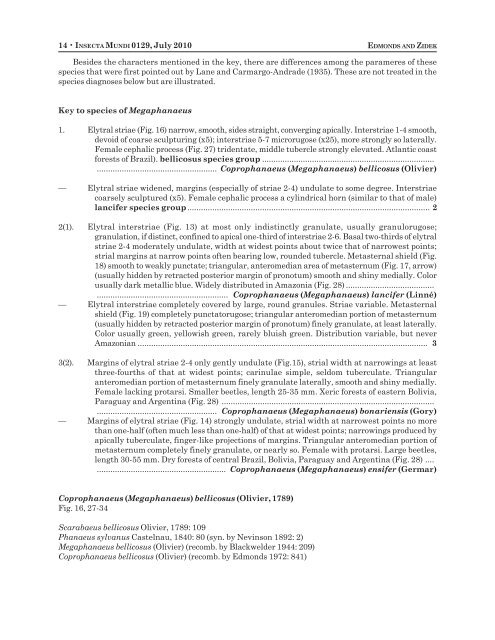insecta mundi - Center for Systematic Entomology
insecta mundi - Center for Systematic Entomology
insecta mundi - Center for Systematic Entomology
You also want an ePaper? Increase the reach of your titles
YUMPU automatically turns print PDFs into web optimized ePapers that Google loves.
14 • INSECTA MUNDI 0129, July 2010 EDMONDS AND ZIDEK<br />
Besides the characters mentioned in the key, there are differences among the parameres of these<br />
species that were first pointed out by Lane and Carmargo-Andrade (1935). These are not treated in the<br />
species diagnoses below but are illustrated.<br />
Key to species of Megaphanaeus<br />
1. Elytral striae (Fig. 16) narrow, smooth, sides straight, converging apically. Interstriae 1-4 smooth,<br />
devoid of coarse sculpturing (x5); interstriae 5-7 microrugose (x25), more strongly so laterally.<br />
Female cephalic process (Fig. 27) tridentate, middle tubercle strongly elevated. Atlantic coast<br />
<strong>for</strong>ests of Brazil). bellicosus species group ............................................................................<br />
..................................................... Coprophanaeus (Megaphanaeus) bellicosus (Olivier)<br />
— Elytral striae widened, margins (especially of striae 2-4) undulate to some degree. Interstriae<br />
coarsely sculptured (x5). Female cephalic process a cylindrical horn (similar to that of male)<br />
lancifer species group ........................................................................................................... 2<br />
2(1). Elytral interstriae (Fig. 13) at most only indistinctly granulate, usually granulorugose;<br />
granulation, if distinct, confined to apical one-third of interstriae 2-6. Basal two-thirds of elytral<br />
striae 2-4 moderately undulate, width at widest points about twice that of narrowest points;<br />
strial margins at narrow points often bearing low, rounded tubercle. Metasternal shield (Fig.<br />
18) smooth to weakly punctate; triangular, anteromedian area of metasternum (Fig. 17, arrow)<br />
(usually hidden by retracted posterior margin of pronotum) smooth and shiny medially. Color<br />
usually dark metallic blue. Widely distributed in Amazonia (Fig. 28) .......................................<br />
.......................................................... Coprophanaeus (Megaphanaeus) lancifer (Linné)<br />
— Elytral interstriae completely covered by large, round granules. Striae variable. Metasternal<br />
shield (Fig. 19) completely punctatorugose; triangular anteromedian portion of metasternum<br />
(usually hidden by retracted posterior margin of pronotum) finely granulate, at least laterally.<br />
Color usually green, yellowish green, rarely bluish green. Distribution variable, but never<br />
Amazonian ................................................................................................................................ 3<br />
3(2). Margins of elytral striae 2-4 only gently undulate (Fig.15), strial width at narrowings at least<br />
three-fourths of that at widest points; carinulae simple, seldom tuberculate. Triangular<br />
anteromedian portion of metasternum finely granulate laterally, smooth and shiny medially.<br />
Female lacking protarsi. Smaller beetles, length 25-35 mm. Xeric <strong>for</strong>ests of eastern Bolivia,<br />
Paraguay and Argentina (Fig. 28) ..............................................................................................<br />
..................................................... Coprophanaeus (Megaphanaeus) bonariensis (Gory)<br />
— Margins of elytral striae (Fig. 14) strongly undulate, strial width at narrowest points no more<br />
than one-half (often much less than one-half) of that at widest points; narrowings produced by<br />
apically tuberculate, finger-like projections of margins. Triangular anteromedian portion of<br />
metasternum completely finely granulate, or nearly so. Female with protarsi. Large beetles,<br />
length 30-55 mm. Dry <strong>for</strong>ests of central Brazil, Bolivia, Paraguay and Argentina (Fig. 28) ....<br />
......................................................... Coprophanaeus (Megaphanaeus) ensifer (Germar)<br />
Coprophanaeus (Megaphanaeus) bellicosus (Olivier, 1789)<br />
Fig. 16, 27-34<br />
Scarabaeus bellicosus Olivier, 1789: 109<br />
Phanaeus sylvanus Castelnau, 1840: 80 (syn. by Nevinson 1892: 2)<br />
Megaphanaeus bellicosus (Olivier) (recomb. by Blackwelder 1944: 209)<br />
Coprophanaeus bellicosus (Olivier) (recomb. by Edmonds 1972: 841)



